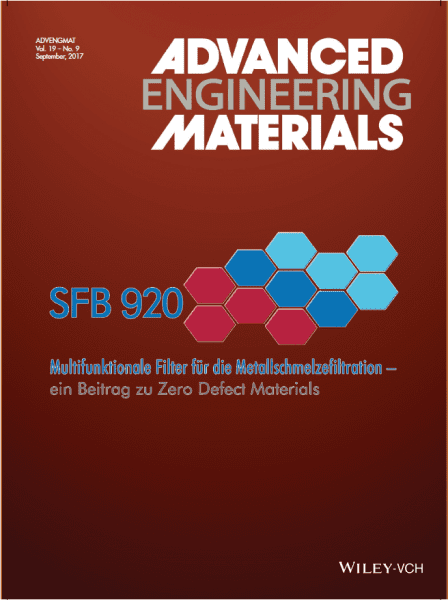Advanced Engineering Materials has been bringing you the latest breakthroughs in structural materials that are making those important first steps towards commercialization since 1999. With its further increased, record-high Impact Factor of 2.319 (2017 Journal Citation Reports), the journal covers a variety of key topics, such as composites, ceramics, intermetallics, and coatings, and also high-temperature, cellular, and biomedical materials, with a strong focus on new manufacturing techniques.
No access to our published content? Make sure to recommend Advanced Engineering Materials to your librarian. More information can be found here.
In this monthly feature, we highlight the research behind the artwork on the covers of the most recent issue of Advanced Engineering Materials, as well some of the most read Advanced Engineering Materials publications over the last month. These top-downloaded articles are therefore currently freely accessible! Click on the titles below to get to the corresponding papers. You can find this month’s issue here. Also check out our previous Engineering Digest here.
Special Issue: Multi-Functional Filters for Metal Melt Filtration
Issue: Multi-Functional Filters for Metal Melt Filtration
This special issue, guest-edited by Christos Aneziris (TU Bergakademie Freiberg) and Tobias Fey (FAU Erlangen-Nürnberg), focuses in a comprehensive way on selected results covering the entire chain of metal melt filtration. Groundbreaking results from the Collaborative Research Center (CRC) 920 “Multi-functional filters for metal melt filtration – a contribution towards zero-defect materials” are presented.
 The CRC 920 focuses on researching a new generation of metal qualities with superior mechanical properties via melt filtration, also during recycling, for use in lightweight structures and high-demand construction materials. The aim of the CRC is an enormous reduction of non-metallic inclusions in the metal matrix by the use of intelligent filter materials, as well as filter systems, due to a functionalized filter surface.
The CRC 920 focuses on researching a new generation of metal qualities with superior mechanical properties via melt filtration, also during recycling, for use in lightweight structures and high-demand construction materials. The aim of the CRC is an enormous reduction of non-metallic inclusions in the metal matrix by the use of intelligent filter materials, as well as filter systems, due to a functionalized filter surface.
Filtration efficiencies above 95% could be achieved with the new filter system approaches. In addition, a better understanding of the impact of the filter material on the resulting properties was achieved. Based on the specific filter system design, the contribution of the filter material to the filtration performance is at least equal to the contribution of the flow.
A more extensive news article about this special issue can be found here.
High‐Entropy Alloy (HEA)‐Coated Nanolattice Structures and Their Mechanical Properties
by Libo Gao, Jian Song, Zengbao Jiao, Weibing Liao, Junhua Luan, James Utama Surjadi, Junyang Li, Hongti Zhang, Dong Sun, Chain Tsuan Liu, and Yang Lu
Nanolattice materials with ordered three-dimensional architectures are recently of extensive interest due to the rapid advances in additive manufacturing at the micro- and nanoscale. High-entropy alloys (HEA), a new type of alloy constructed with five or more principal elements, exhibit exceptional properties owing to their unique alloy design concept, such as tunable compositions, microstructures, and particularly, tunable mechanical properties. Yang Lu and colleagues from the City University of Hong Kong demonstrate the first microfabricated 3D HEA (CoCrFeNiAl0.3)-coated nanolattice structures, which show structural uniformity and desirable mechanical strength.
A more extensive news article about this work can be found here.
Current Status and Recent Developments in Porous Magnesium Fabrication
by Alicja Kucharczyk, Krzysztof Naplocha, Jacek W. Kaczmar, Hajo Dieringa, and Karl U. Kainer
An intercollegiate team of researchers from Wrocław University of Science and Technology and Helmholtz-Zentrum Geesthacht summarizes in this recently published article the current state of porous magnesium manufacturing with descriptions of the various fabrication methods and properties of magnesium “sponges”. Additionally, they describe corrosion resistance of magnesium foams and briefly review the differences between aluminum and magnesium foams made in the same way.
A more extensive news article about this work can be found here.
Printing Polymer Nanocomposites and Composites in Three Dimensions
by Rouhollah Dermanaki Farahani and Martine Dubé
3D printing might be able to revolutionize manufacturing approaches in a wide range of industries. Rouhollah Farahani and Martine Dubé from the École de Technologie Supérieure in Montréal, Canada discuss the numerous benefits provided by 3D printing, such as ease of use, growing reliability, cost-effectiveness, design freedom, diversity of compatible materials, and multimaterial printing. However, as typical printing materials have low mechanical strength and no functionality, new materials need to be developed. The capability for customized geometries combined with improved materials’ properties using reinforcements will enable tailoring final properties of the manufactured parts, pushing 3D printing from prototyping to fabrication of high-end products.
A more extensive news article about this work can be found here.

















